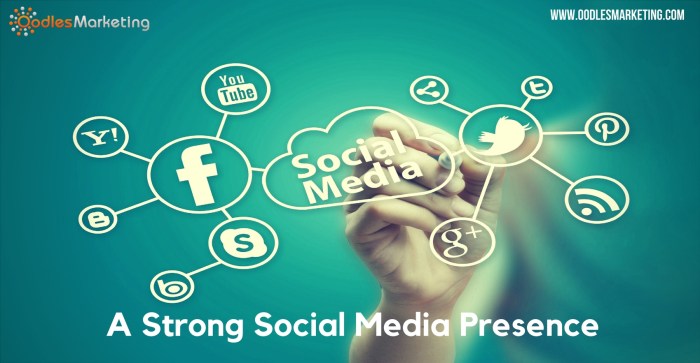Building a Social Media Presence for B2B kicks off with a deep dive into the strategies and tactics essential for elevating brand visibility and driving lead generation in the B2B realm. Get ready to explore the dynamic world of B2B social media marketing with a fresh perspective!
Let’s uncover the secrets behind successful B2B social media campaigns and how they translate into tangible business outcomes.
Importance of Building a Social Media Presence for B2B

In today’s digital age, having a strong social media presence is essential for B2B companies to stay competitive and reach their target audience effectively.
Enhanced Brand Visibility
Social media platforms offer B2B companies a unique opportunity to showcase their brand and connect with potential clients on a more personal level. Successful B2B social media campaigns can significantly enhance brand visibility and recognition in the market.
Increased Lead Generation and Conversions
A well-established social media presence can lead to increased lead generation and conversions in the B2B sector. By engaging with prospects through social media channels, companies can build trust, credibility, and relationships that ultimately lead to more conversions and sales.
Choosing the Right Social Media Platforms for B2B

When it comes to B2B social media marketing, choosing the right platforms can make a big difference in reaching your target audience effectively. Let’s dive into the key social media platforms that are most effective for B2B companies and compare the advantages and disadvantages of using LinkedIn, Twitter, and Facebook.
LinkedIn is a powerhouse for B2B companies looking to network, build relationships, and share industry insights. Here are some key points to consider:
- Advantages:
- Professional network: LinkedIn is the go-to platform for B2B professionals, making it ideal for reaching decision-makers.
- Content sharing: You can easily share articles, whitepapers, and thought leadership content to establish credibility.
- Disadvantages:
- Cost: LinkedIn advertising can be expensive compared to other platforms.
- Competition: With many B2B companies on LinkedIn, standing out can be a challenge.
Twitter is a fast-paced platform that can be great for real-time engagement and brand awareness. Here’s what you need to know:
- Advantages:
- Real-time updates: Twitter allows you to quickly share updates, news, and engage with your audience.
- Hashtag visibility: Using relevant hashtags can help your content reach a larger audience.
- Disadvantages:
- Character limit: The 280-character limit can make it challenging to convey complex messages.
- Noisy feed: With a constant stream of tweets, your content can easily get lost in the noise.
While Facebook is more commonly associated with B2C marketing, it can still be effective for B2B companies. Here’s how you can leverage it:
- Advantages:
- Targeting options: Facebook’s detailed targeting options allow you to reach specific B2B audiences.
- Visual content: You can use images and videos to showcase your products or services in a more engaging way.
- Disadvantages:
- Algorithm changes: Facebook’s algorithms can impact organic reach, requiring paid advertising for visibility.
- B2C focus: With a more consumer-centric user base, B2B content may not always resonate as well.
Developing a Content Strategy for B2B Social Media: Building A Social Media Presence For B2B
Creating valuable and engaging content for B2B audiences on social media is crucial for establishing credibility, building relationships, and driving conversions. B2B decision-makers are looking for informative content that helps them solve problems and make informed choices.
Content Formats for B2B Social Media
- Case Studies: Showcasing real-life success stories can help potential clients see the value of your products or services.
- Whitepapers: In-depth reports that provide valuable insights into industry trends, research findings, or best practices can position your company as a thought leader.
- Webinars: Hosting webinars on relevant topics allows you to engage with your audience in real-time, share expertise, and generate leads.
Content Calendar for B2B Company
- Monday: Share a new blog post or article related to industry trends or insights.
- Wednesday: Post a customer testimonial or case study highlighting a successful partnership.
- Friday: Host a live webinar or Q&A session to engage with your audience directly.
Engaging with the B2B Audience on Social Media
In today’s digital age, engaging with your B2B audience on social media is crucial for building strong relationships and driving business growth. By fostering meaningful interactions, establishing thought leadership, and effectively responding to comments and messages, you can enhance credibility and connect with key stakeholders in your industry.
Fostering Meaningful Interactions, Building a Social Media Presence for B2B
- Personalize your interactions by addressing B2B customers and prospects by name.
- Create engaging content that sparks conversations and encourages feedback.
- Ask thought-provoking questions to prompt discussions and gather insights.
- Show appreciation for feedback and testimonials to strengthen relationships.
Establishing Thought Leadership
- Share valuable industry insights, trends, and expertise to position your brand as a trusted authority.
- Create and share original content such as whitepapers, case studies, and webinars to showcase thought leadership.
- Engage in conversations with industry influencers and participate in relevant discussions to demonstrate expertise.
- Consistently deliver high-quality content that adds value to your B2B audience.
Effectively Responding to Comments and Messages
- Monitor social media platforms regularly for comments, messages, and inquiries from B2B stakeholders.
- Respond promptly and professionally to address questions, concerns, and feedback.
- Personalize responses and show empathy to demonstrate genuine interest in customer needs.
- Redirect complex inquiries to appropriate channels for further assistance and resolution.